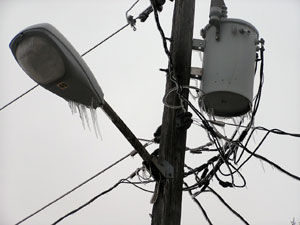|
Audio
Photos
More from MPR
Resources
|
 |
| Officials say improvements to the power grid system since 2003 helped prevent a regional blackout during the recent ice storm and blizzard. (MPR file photo/Dan Gunderson) |
Moorhead, Minn. — Hundreds of utility workers across Minnesota, North Dakota and South Dakota are starting to catch their breath after long days in brutal conditions, and Xcel Energy Director of Transmission Operations Greg Pieper says those who manage the electrical grid are reviewing the response to the storm.
"To be honest with you, this is actually going to be categorized as a near miss of a potential regional outage," says Pieper. "Reports will be written around that kind of a flavor to it. They will be provided as examples of how you can be successful in dealing with these issues."
Experts say a blackout was avoided because the grid management system worked, and because people voluntarily used less electricity.
Oversight for the electric grid is the responsibility of the Midwest Independent Transmission System Operator -- MISO. The organization monitors electrical generation and transmission in an area from the Dakotas to Ohio. It works with utilities to balance power transmission with power demand. When power lines go down, that system gets out of balance, and MISO predicts what effect that will have on the regional power grid. MISO also has authority to order localized blackouts to prevent larger failures of the electric grid.
The MISO was criticized for not acting quickly enough when a major blackout hit the Midwest and the eastern United States in August, 2003.
But officials say improvements to the system since 2003 helped prevent a regional blackout during the recent ice storm and blizzard.
MISO Senior Vice President and Chief Operations Officer John Bear says MISO now has access to more data from utilities which allows it to more quickly analyze what's happening to the electric grid using complex computer models.
"Not only to understand where the system is, but also to understand given current assumptions, where the system could go should certain lines go out of service," says Bear.
Xcel Energy officials agree better data sharing helped successfully manage significant electrical tansmission line damage caused by ice and wind.
MISO also has authority to order rolling blackouts to protect the rest of the electric grid against a catastrophic failure.
Bear says utilities take pride in keeping the lights on and that makes it difficult to voluntarily cut off power to customers.
"For example, in the past, you may have asked utility A to reduce load by 20 megawatts. And that would have preserved the system for five, six, seven utilities. That's not an easy thing to do. And it's for the greater good," says Bear. "Now when that direction is given, it happens right away and there's no debate whether that's going to happen."
During the recent ice storm, MISO ordered an emergency which allowed it to order localized blackouts.
Xcel Energy officials say one lesson that may be learned from the ice storm is that MISO could more quickly recognize the need for an emergency.
The emergency status allows rolling blackouts to be ordered, and it also allows utilities to tell the public there's a critical situation and energy conservation is essential.
Xcel Energy Director of Business Relations Robin Kittle, says many consumers contract with Xcel to reduce electric use when demand is high. But she says voluntary energy conservation was key to avoiding blackouts being ordered by MISO
"The ability to allow customers to help us manage this situation was extremely beneficial as opposed to the command and control that MISO could have ordered to prevent any type of cascading," says Kittle.
Cascading is what happens when the electric grid is overloaded and begins to automatically shut down. It usually leads to a system-wide, multi-state blackout.
Xcel Director of Transmission Operations Greg Pieper says in the end, something as simple as thousands of people turning out lights may have prevented a blackout.
"One of the things that was in our messages was to conserve energy, don't use your Christmas decorations, for example don't turn on your lighting," says Pieper. "We were very concerned at that point that was going to drive the load up and cause us to be in an insecure condition."
Pieper says after utilities asked the public to conserve, there was an immediate, significant drop in electric demand.
It will be several months before MISO and its member utilities complete a final report on the ice storm response.



